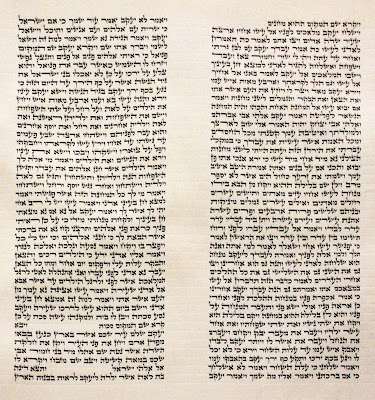Then there are the four questions. The youngest child asks the four questions – and then we don’t answer them. Instead, we recite a paragraph proclaiming it is our duty to tell the story of Passover. Do we then tell the story of Passover? No, next we tell the story about five rabbis who once had a Seder during Roman times. After that, we tell the story of four different kinds of children. We immediately move on to describe how Abraham came from a family of idol worshipers. We then begin a completely different story, one in which Laban tried to harm Jacob. By this time, one could not blame the participant in the Seder for being totally confused! Then there are the songs – I love the songs. But tell me – what does “Who knows one, I know one” have to do with Passover? One of my favorite songs, “Adir Hu” has seemingly nothing to do with Passover. It a song in praise of G-d and a plea that the Temple in Jerusalem should be speedily rebuilt in our day! The song where the dog bites the cat that eats the goat that my father bought… what does that have to do with Passover? The miracle of Passover seems to be that with such a disjointed way of telling the story, and with songs that are irrelevant to the occasion, we actually have managed to transmit the story of Passover through the ages to our children. If the Haggadah is not very good story telling, then what is it? I would like to suggest that the Haggadah is very good at teaching us about freedom. In January, 1941, with war in Europe and Japan threatening from the Far East, President Franklin Roosevelt outlined the four freedoms that he said were fundamental to a free society. Those four freedoms were freedom from want, freedom of speech and expression, freedom from fear and freedom of worship. I think our Seder teaches about these very freedoms that President Roosevelt outlined very, very well. How does the Seder begin? Ha Lachma Anya – before it has anything to say about freedom, it begins by addressing hunger and need. “Let all who are hungry come and eat”. It has its priorities correct. If one is hungry, if one is in need, there can be no freedom. Before we can even talk about freedom, those who are hungry need to be provided for. Freedom from want, however, is not enough. A society must provide opportunities to its members in order for people to be truly free. As Mordechai Kaplan once wrote, “Freedom without opportunity is like appetite without food.” Next in our Seder we have the four questions. This too, teaches us about freedom. Without freedom of speech, without the freedom to ask questions of those who are in authority, there is no freedom. So we can ask questions, like – How is it that a man in Florida can shoot and kill another man who is not armed, and not be arrested by the police or charged with a crime? We can ask – does it have to do with the fact that the perpetrator was white and the victim was black? We can ask – Why was there apparently no attempt to contact the loved ones of the victim through his cell phone, which was still on his body when it was taken to the morgue? Asking questions – until we get answers – can be, as we saw this week, very effective. Next, we must have Freedom from Fear. “Come let us learn,” says our Haggadah, “What Laban the Aramaen tried to do with our father Jacob. While Pharaoh decreed only against the males, Laban tried to uproot us all.” In order to be free, one must live in peace and in security. The killing of three Jewish schoolchildren and a rabbi in France several weeks ago reminds us anew of the hatred that some in this world harbor toward our people. Indeed, with the threat of nuclear proliferation in North Korea and Iran, none of us can say yet that we are truly free. Finally, what is the ultimate goal of the exodus from Egypt? What reason does Moses give to Pharaoh over and over to let the Jewish people go? It is so that they could worship G-d in their own way. The culmination of the Exodus from Egypt is the revelation of Mt. Sinai and the covenant that is established between the Jewish people and G-d. This story of the search for religious freedom was the inspiration for the Puritans to come to this country in 1620. The Puritans identified themselves with the ancient Hebrews and sought to establish a New Israel on the shores of this continent, where they could find freedom from the religious despotism of England. Freedom of worship is that fourth freedom that Roosevelt spoke about. No, the Haggadah may not be very good at actually TELLING the story of Passover. I imagine a person sitting down to a Seder for the first time, without having read the biblical account of the Passover, would get up from the Seder feeling very confused about what happened. At the same time, that person would have learned a great deal about freedom – about freedom from want and hunger, freedom to question, freedom to live without fear, and freedom for each person to worship as they want – the freedoms that we all aspire to if we are truly to live free. Hag Sameach and Shabbat Shalom Rabbi Marc D. Rudolph
Passover 5772
The Four Freedoms
Passover is the holiday of storytelling par-excellence. We are told four times in the Torah that we must tell our children the story of Passover. We have developed an elaborate ritual, the Seder, to fulfill this commandment, and a book, the Haggadah, literally, “The Telling” to teach our children the story. But, for my money, the Haggadah does a poor job of telling the story. I know we Jews have been using it for almost two thousand years, but what kind of way is this to tell a story? We do not mention Moses in the traditional Haggadah. But Moses is the central person in the entire story of the Exodus! Could someone teach about the Civil War, without mentioning Abraham Lincoln? Could someone teach about the American Revolution without telling about George Washington? But the Haggadah tells the story of Passover, for hours upon hours, without once mentioning Moses!


